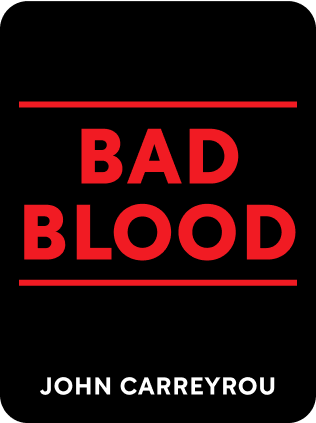

This article is an excerpt from the Shortform book guide to "Bad Blood" by John Carreyrou. Shortform has the world's best summaries and analyses of books you should be reading.
Like this article? Sign up for a free trial here .
What is Bad Blood by John Carreyrou about? How does Bad Blood‘s John Carreyrou explain the rise and fall of health company Theranos?
John Carreyrou was a journalist who originally broke the story of Theranos at the Wall Street Journal. In Bad Blood, John Carreyrou breaks down what happened and his investigation.
Read more about Bad Blood, John Carreyrou, and the Theranos story.
Bad Blood: John Carreyrou’s Investigation
Bad Blood: Secrets and Lies in a Silicon Valley Startup is written by John Carreyrou, the very Wall Street Journal reporter who first exposed Theranos. It covers all known history of how Theranos started, maintained its lies, and fell.
The story is an incredible demonstration of the weaknesses of human psychology. Even very sophisticated investors, whose job is to sniff out these exact situations, fell completely for the fraud until it was exposed.
Beyond just detailing the chronology of the story, our Bad Blood summary covers three major questions:
- How did the deception begin?
- How was the deception allowed to continue?
- What finally led to Theranos’s downfall?
We’ll focus on the themes of why so many sane, professional people were completely taken in and ignored the warning signs until it was too late. In Bad Blood, John Carreyrou uncovers this and more.
Bad Blood: John Carreyrou Uncovers Deception
It has to start with Elizabeth Holmes, who dreamed big. She clearly had large ambitions. When asked what she wanted to be at 10 year old, she answered “a billionaire.”
Theranos had a vision people wanted to believe in – “detect diseases early so no one has to die unnecessarily.” All types of stakeholders saw what they wanted to see in it, allowing large suspension of disbelief.
- Investors saw a huge financial opportunity. The medical testing market is huge – allowing patients to test at home, and using the resulting data to inform medical decisions, makes it even bigger.
- Patients and their families saw better decisionmaking and less pain.
- The public saw a thrilling female founder who could be the next Steve Jobs. They wanted to celebrate a brilliant female innovator in an age of female empowerment.
- Partners like Walgreens and Safeway saw a way to compete against competitors like CVS, and to rejuvenate their financials. So they partnered with Theranos to roll out
Elizabeth Holmes practiced charismatic techniques to win over supporters.
- Elizabeth spoke sincerely and enthusiastically about the mission. It gave the impression that there was no way someone with this sincerity could be beguiling.
Stakeholders used pattern matching to jump to wrong conclusions.
- On paper, the technology fit the pattern of disruption – dramatically lower cost replacing the dinosaur incumbents, leading to massive adoption and market expansion. The story was intoxicating and irresistible.
- Holmes looked like the stereotypical genius dropout founder. She even deliberately cast a resemblance to Steve Jobs with black turtlenecks.
How Did the Deception Continue?
To hide the fact that their proprietary machine that didn’t work, Theranos crossed the limits of scientific legitimacy. These were non-standard distortions of scientific practice. In Bad Blood, John Carreyrou explains.
- In coefficient of variation studies (a measure of precision and repeatability), deviant results were repeated until they got satisfactory results – basically retaking a test until you get the right answers. Furthermore, they used only the median values of 6 replicates, guaranteeing a tighter CV.
- In quality control checks, outliers were inappropriately thrown out – basically changing the answer to get what you want.
When scientific manipulation wasn’t enough, Theranos actively deceived people and lied by omission.
- To press and investors, Elizabeth embellished claims level of accuracy and number of assays that could be run on their proprietary machine.
- Theranos was scheduled to run demonstrations for pharmaceutical company partners. When their devices didn’t work live, they ran fake demonstrations instead.
When company insiders doubted the company’s strategy, Theranos actively quashed dissent.
- Non-believers were quickly fired for being disruptive, then bound by an NDA so they couldn’t leak details to press. Instead, sycophants and order-followers were promoted.
- Former employees who were suspected of leaking bad information were threatened legally and monitored by private investigators.
Mental biases like fear of missing out and sunk cost fallacy prevented partners from looking deeper.
- Partner company Walgreens couldn’t pull out despite mounting doubts about Theranos. If the innovation were real, it couldn’t risk CVS taking it. Furthermore, it had already shouldered the money of the building out new clinics, and once it got deep enough, pulling out would have been intensely embarrassing.
- Because of all the hype, the investing rounds in Theranos were hot. Therefore, investors didn’t have the time to pause for deep due diligence. If they did express doubt and ask for more time, they’d likely be excluded from the deal.
How Did the Deception End?
Theranos overreached in ambition, causing them to require delivering at some point.
- They promised too much to Walgreens and had to deliver. This prompted them to cheat.
Theranos stepped too far down the slippery slope of deception, until even their strong-arm tactics couldn’t hold back a conscience.
- Embellishing results in prototyping phase was somewhat acceptable. Lying about real patient data, which affected clinical decision making, crossed the line for many employees.
- Many employees left; most stayed quiet due to fears of reprisal; some brave whistleblowers let conscience override fear, and they reported to regulators and reporters.
A journalist fought for the story.
- Despite continuing threats of litigation, harassment of his sources, and personal surveillance by private investigators, John Carreyrou pressed forward with his story, knowing it would be big. Arguably, without his story, Theranos would have been allowed to persist for years longer, harming many more patients.
In the downfall, momentum and vicious cycles are as punishing as they are powerful on the way up.
- Once the evidence of Theranos’s failure became clear, the flywheel effect worked in the opposite direction. Walgreens dropped the partnership; regulators fixated their attention on Theranos; the public lambasted her and the gullibility of Theranos’s supporters; sources readily reached out to reporters to share useful information; investors sued Holmes for fraud.
In Bad Blood, John Carreyrou investigates this famous company, and helps end this fraud.

———End of Preview———
Like what you just read? Read the rest of the world's best book summary and analysis of John Carreyrou's "Bad Blood" at Shortform .
Here's what you'll find in our full Bad Blood summary :
- How a 19-year-old Stanford dropout created a fraudulent company that deceived savvy investors
- What Theranos claimed their proprietary technology could do
- How psychological biases could cause you to fall for such a deception






